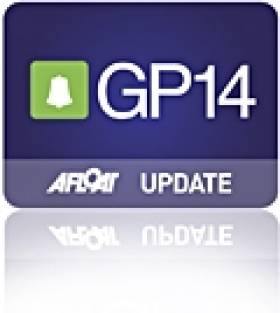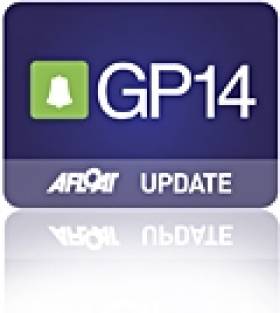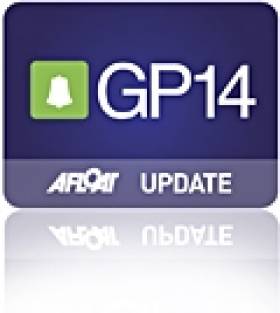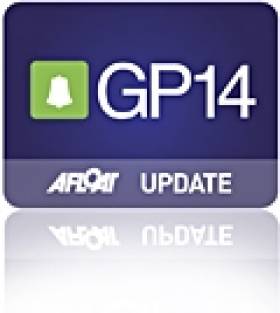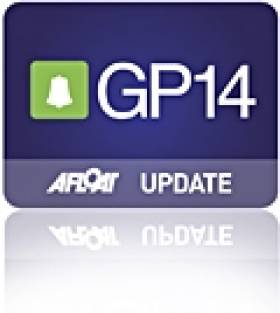Displaying items by tag: GP14
Sponsor Boost for GP14s
#GP14 – Irish GP14 dinghy sailing gets a boost this season with the support of insurance firm Craftinsure for the class national championships The firm has also been selected to handle the GP14 Association insurance scheme with effect from 1st April 2012 following a review by the Association.
The insurance scheme for the GP14 Class Association is one of the longest established, having been in place for over 50 years, and is strongly supported. For much of it's history, the scheme was very successfully managed by long serving GP14 Association member Graham Knox, who still assists with liaison between the Association Committee and their insurance partners.
The new arrangement maintains the long association with Navigators & General (part of Zurich Insurance plc), as all Craftinsure polices are underwritten by N&G.
As a leading online boat insurer in Ireland and the UK, Craftinsure is able to provide a cost effective and convenient insurance facility for GP14 owners. The fact that claims staff along with other key members of the Craftinsure team, are active dinghy sailors was another important factor in the selection process, as was the level of cover and security provided.
The Association will continue to benefit from contributions for each GP14 insured through the scheme, as well as from other forms of support including sponsorship for the 2012 Irish Nationals and the 2012 World Championships
Rod Daniel, director of Craftinsure comments "we are delighted to have been appointed to handle the GP14 scheme and that this Association can be added to IODAI and others where we have a strong affiliation. We look forward to welcoming new and existing GP14 owners to Craftinsure and to supporting the Association as much as possible".
A healthy forty seven dinghies competed for the Irish GP14 National Sailing Championships title last weekend and Greystones sailor Shane McCarthy, now UK based, with crew Andy Davis took the title, winning the last four races. Class president Richard Street gives a blow by blow account of how the title was won.
Skerries was our venue, and a fine spot to host a regatta it is .The GP fleet were really well taken care of by all the members of the club who put aside their own weekend so we could have a lot of fun. Thank you.
Not only were we blessed to have a great turnout, but the calibre of it was pretty impressive too. The top ten counted two World Champions, a European Champion, a two time Olympian, a six time Irish National champion, a multiple English National Champion. Steven Nelson and his brother Jonny slotted right in amongst them to blow most of the Gold fleet away and take the crown in their division by a huge margin.
Race officer Liam Dineen and his crew spent a long weekend at sea for our enjoyment a massive thank you to him and his team. Sunday, especially can not have been easy.
On day one Mike Senior and Chris White were consistency personified, two races, two bullets, as were Shane Mc Carthy and Andy Davis with two seconds.
Race one paid off beautifully for those who headed straight inshore on the first beat, but if you made the mistake of repeating that on the second beat you got hosed. Main feature of the weekend was big breeze and some massive shifts. Keith Louden and Dessie Hughes got their result of the weekend with a third skinning their northern rivals theyoung Mc Guinness boys in the process.cue smiles allround.On one boat.
Race two and a big right shift up the last beat got a few boats that weren’t looking too hot, out of trouble . Curly once had a boat by that name, I think, and he and Laura were chased into third by his daughter Melanie crewing for Ger Owens. Their boat name? True Belle.
Day two Sunday, blowing hard enough that rumour has it the RO wasn’t sending us out. A few launches put paid to that, and we’ve raced in far worse.
The Imperious English pair got their first challenge as Shane and Andy took their first win. They had been led around the first windward mark by Steven and Jonny, as fine a sight as ever we’d see…until they repeated the feat the following day ! Now if the two boys had popped the kite they might have held on to the lead , but they got swallowed up. Mike and Chris had to work to hold onto the leaders and were chased home by Dave Young and Seonaid Fleming who registered their high point for the series. The effort must have taken its toll as they spent a large portion of the afternoon swimming, which meant utter exhaustion for them by the end of the day.Still smiling though.
Race four looked like it might never happen. 30 and 40 degree windshifts coming down the course with each cloudburst. Rain that was thick as fog and more than one attempt at starting which had to be abandonded with twenty seconds to go. Inevitably when the gun did go, a line that ten seconds earlier had been pin end favoured but congested,suddenly got much more so. A big shift to the left saw the fleet react, but back up the line , with room to move, Niall Henry and James Conlon crossed on port at full tilt to negate much of the advantage those by the pin had. In the lightest breeze of the weekend and heading straight into a short steep chop concentration was essential, lose it and you got spat out the back.
The end of that race saw the score tied at two all as Shane took the win followed by Mike Senior.
With a building breeze and direction settling, the course swapped to a quickfire windward leeward. The two leading boats at the top mark both missed the wing, the boys behind said thank you very much. A short windward leg meant a hectic pressurised run, nothing settled until halfway up the second beat. There was little time to catch breath, let alone think. At the end the overall result had reversed itself. While both incredibly consistent, the Irish boat had scored three bullets to Mikes two.
Monday morning, cold and grey. The final denoument. Race five, again a windward leeward and a great breeze, a tight stack at the top mark meant boat handling was at a premium, who popped out in the lead at the top, Shane and Andy, with a narrow lead over a chasing pack which had buried in it the challenger , Mike and Chris had to work hard to stay in contention, those running down the left side of the second run weren’t looking too good until a nice right shift came in making it all look sweeter. At the bottom the Mc Guinness brothers took the stb gate while Shane went to the left, they rounded in exact sequence but someone had picked the wrong side. Shane and Andy took the gun and with it the title. Curly Morris and crew Laura Mc Farland had come around the bottom three or four back but played a beautiful final beat to come away with second.
The new Champions headed for shore and a tepid shower, while a new winner Clive Goodwin and Thomas stepped up onto the podium in race seven.Nigel Sloan and Micheal Cox had a stunning race to fend off an Olympian and grab second place. Well done boys.
Irish National Champions 2011. Shane Mc Carthy and Andy‘ Taxi ‘ Davis.
Runners up, Mike Senior and Chris White.
Winners in the Silver Fleet Steve Nelson and his brother Johnny.
Winners of the Bronze fleet ,local Skerries crew,Shay McGee and Owen Boylan.
Well done Skerries. And thank you.
MacCarty/Davis Win GP14 Leinsters
The GP14 Leinster Championship was held in Skerries Sailing Club over the weekend of the 25th and 26th of September, with a great turnout of 40 boats. As usual the members of SSC pulled out all the stops to ensure a great weekend was had by all writes Libby Tierney.
A special mention must go to the PRO, Liam Dineen and his team who expertly managed the racing. As someone who's been racing for years (not very well!) There hasn't been many events I've been to, where I've gotten four hour long races in a single day, with such a slick turnaround between races.
Day one kicked off with moderate NE winds causing a sloppy sea for the competitors.
Race 1 kicked off the a great start for the McGuinness brothers who secured the first bullet of the event, Duffin/Whitecomb taking second & Tiarnaigh/Tierney taking 3rd.
Race 2 Saw Owens/Morris winning easily, with this there only 2nd event I think we should be all worried. 2nd was taken again by Duffin/Whitecomb team with 3rd being snapped up by McCarty/Davis.
Race 3 Saw another bullet from the pairing of Owens/Morris, with MacCarty/Davis moving up another place to get 2n, with the Morrison brothers getting 3rd.
Race 4 Had MacCarty/Davis get there first bullet of the event, 2nd was the Goodwin brothers and 3rd was Tiarnaigh/Tierney combination.
After race four all the competitors made there was back to SSC for a well-deserved BBQ & drinks.
Day two saw light, variable & shifty winds which promised to make things interesting for the fleet.
Race 5 had the Goodwin brothers get there first bullet with MacCarty/Davis in 2nd and the McGuinness brothers taking 3rd
Race 6 the penultimate race of the championship found MacCarty/Davis finishing in 1st, Owens/Morris in 2nd & the Goodwin brothers in 3rd. This is also how the overall event finished up.
A special acknowledgement must go to the only all-female paring of the event, Kissane & McCormack who also took the Leinster Youth Title..
Results attached for download below
Corcoran and Brogan Best of Irish at GP14 Nationals
Newtownards Sailing Club hosted this year's GP 14 Championship of Ireland. The event attracted 46 boats from throughout Ireland and Great Britain. Race Officer Nigel Kearney set excellent courses in what was some of the most testing conditions in recent years.
Form race one the weather conditions were steadily worsening; average wind speeds were in excess of 20 mph with gusts to 25 mph and occasionally 30 mph. The dark heavy sky laden with squalls added to the drama. As the fleet got underway, boats capsized on and after the starting. The strong wind made tactics of less importance than just sheer boat handling.
Rarely, for the GP fleet, many competitors opted not to fly the spinnaker on the downwind legs and those that did ran the risk of a capsize especially at the gybe mark which got very congested with upturned boats. The windward legs sapped the energy of helm and crew. The race was won by Tim Corcoran from Sligo.
Race two and the weather seemed to deteriorate further. Adding to the problem was the sea state - in an unusual swell for the North end of Strangford Lough and after the gruelling first race gave the competitors even more to contend with. Winner of the second race was Carl Jeffs from Trimley Sailing Club. The second day's sailing was cancelled due even stronger winds.
As a total contrast day three was glorious sunshine but light winds. Tactics came into play here and the English pairing of Andy Tunnicliffe and Chris Robinson reigned supreme, winning both races to give them the Championship overall.
Results: 1st Andy Tunnicliffe and Chris Robinson RWYC; 2nd and top Irish boat Tim Corcoran and Brendan Brogan, SYC; 3rd Carl Jeffs and Steve Parker TSC.
1st Silver Fleet: Cathal Sheriadan and David Cook, Skerries SC; 2nd Lawrence Baalham and Tony Brown, Newtownards Sailing Club 3rd G O'Sullivan and H McNally
1st Bronze Fleet: Maurice Baalham and Gary Brown, Newtownards Sailing Club; 2nd Bill Johnston and Styephen Byrne LFYC; 3rd I Beattie Orr and R Murray SDC.
Sligo Yacht Club hosted the GP 14 Summer Open and Irish Youth Championships at Rosses Point on the 24th and 25th July.
26 boats lined up at the start. Gus Henry, himself a GP 14 sailor can always be relied upon to provide exceptional race management. He called back race 1 after a significant wind change. The race started proper a short while after that. Keith Louden and Dessie Hughes from Lough Foyle Yacht Club got to the weather mark first in 12 knots of wind, followed by local sailors Niall Henry and James Conlon. In third, Shane McCarthy and Al Fry followed close behind in their new boat. Niall Henry took line honours in the race after sailing a flawless race and taking the lead on the second beat. Paddy O'Connor and Tania McHale climbed from fourth to take second. McCarthy and Fry took third.
Race 2 followed shortly after. This time, there was a definite interest by Paul Maguire and Niamh McCormick from Sutton SC in the right hand side as the tide was picking up in pace. Alastair Duffin and Paul Whitcombe from Newtownards SC went that way too but not quite as far out. Shane and Fry chose the middle route, while the Mc Guinness Brothers from Moville Boat Club initially went left and then back into the middle right. At the weather mark, Maguire and McCormick had a clear lead with McCarthy and Fry in second with the McGuinness brothers a short distance away. The McGuinness brothers passed McCarthy and Fry on the second reach. Maguire and McCormick maintained their lead to the finish with half a boat length to spare at the end with the Donegal team a close second.
Race three got under way in similar wind to the first day but this time the tide was going out. The boats that went left looked good initially, but their hopes were soon dashed as the right side of the fleet piled in to the weather mark. Henry and Conlon though, who had sailed a middle course got to the weather mark first with about 7 boat lengths to spare. They let nothing slip and finished with a convincing first. With 1-5-1 in a four race series, they couldn't be beaten and didn't start race 4. The McGuinness brothers won race four taking the lead in the first reach, leaving them second overall. Conor Byrne and Pamela Lee, first time GP sailor were second and O'Connor and McHale finished third giving them third in the event.
The silver fleet was won by Nigel Sloane and Laura McFarland with Gerry Gilligan and Lucia Nicholson in second and Johnny Park and Bob Stinson in third.
The bronze fleet was won by Conor Byrne and Pamela Lee, Wai Manu and Don MacCormack in second and Bill Johnson and Stephen Byrne in third.
Irish Sailing Classes and Associations
Spoiled for Choice
There’s no shortage of one-design classes from which to choose and each gives its enthusiasts great competition, fun and camaraderie, writes Graham Smith in this review of the classes. A profile of each active class in Ireland is supplied below; just click on the title link (in bold) or the Class Association link to go directly to the information.
One-design racing is where it all starts. It is, after all, where all the top sailors earned their stripes, battling away for line honours without a thought for a handicapper’s calculator wiping away a hard-fought victory!
Indeed, you could count on less than one hand the number of top Irish sailors who didn’t cut their teeth in a one-design dinghy! Just think of Cudmore, Barrington, Watson, Wilkins, Hennessy and Dix to name a few and you realise that they honed their skills in everything from Enterprises to Lasers and a lot in between.
At present count, there are a little over 30 one-design classes in Ireland, split almost evenly between dinghies and keelboats, a statistic which might raise a few eyebrows. They range from the long-established Mermaids, IDRA14s and Dragons to the newer additions like Fevas, Topaz and RS Elite. They all fill a particular need and give their owners and crews considerable enjoyment.
Many have attracted their World or European Championships to Irish waters over the years and while 2009 is notable for a lack of such events here, the following year will see the Etchells Worlds at Howth and perhaps a few other international regattas too.
In addition to the review, we asked each class to complete a questionnaire giving details of their fleet numbers, whether they were on a growth pattern or holding their own, so we could highlight those ‘on the up’ and those remaining static in terms of numbers. The older traditional designs, as you might imagine, fall into the latter category, although that’s not a negative!
CLASS REVIEW The State of the Classes – League Table (as at February 2009)
S = Static; U = Up/growing
275 Optimist U
200+ Laser S
189 Mermaid S
160 Flying Fifteen S
130 RS Feva U
115 Shannon One Design U
100+ Mirror S
100+ Topper U
99 Topaz U
94 Laser SB3 U
87 GP14 U
85 Squib S
70 Fireball S
70 Ruffian S
60 J24 S
60 Shipman S
52 Dragon S
50 RS400/200 S
50 420 U
43 Multihulls U
42 Dragon S
40 Water Wags U
40 Wayfarer S
34 IDRA14 U
33 Puppeteer U
28 Etchells S
27 E-Boat U
26 Glen S
25 Enterprise S
18 Sigma 33 S
18 Howth 17 U
13 RS Elite U


























